In recognition of Virgin Australia marking 10 years of operations between Australia and the United States, this week’s Throwback Thursday is from the April 2009 edition of Australian Aviation, where Geoffrey Thomas looks at the launch of the airline then known as V Australia.
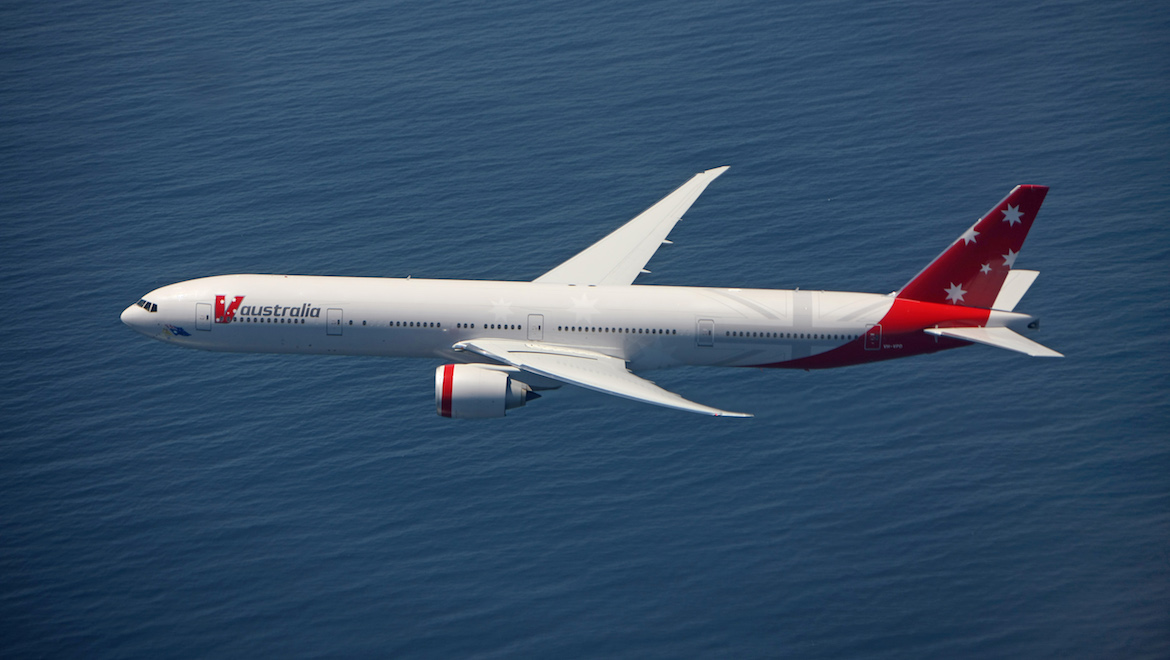
Three years in the making, Australia’s newest long haul international airline, V Australia, made its inaugural revenue flight from Sydney to Los Angeles on February 27, flying in to do battle on the Qantas-dominated trans-Pacific market.
Virgin Blue’s long haul international offshoot has become Australia’s third major international airline (counting Jetstar), launching daily services from Sydney to LA with an initial fleet of two Boeing 777-300ERs.
From March 1 V Australia was due to start services from Brisbane to LA three times a week and from September 15 will fly three weekly flights from Melbourne to LA.
Within the next 12 months V Australia also plans to be flying west to Johannesburg, South Africa, and says it will announce further routes.
On Australia Day (January 26), and just under a month before the airline’s inaugural service, V Australia took formal possession of its first 777-300ER, VH-VOZ Didgeree Blue, in Everett, Washington State.
VH-VOZ, the Virgin Blue group’s 78th new aircraft in nine years, is leased to V Australia from ILFC. It was the leasing giant’s 76th new 777 and its 672nd new aircraft purchased since 1978.
V Australia’s second 777, VH-VPD, landed in Brisbane on February 20, joining the airline in time to commence its initial services. VPE is scheduled to arrive in early April and VPF in July. The remaining three 777s, VPH, VPI and VPJ are scheduled to be delivered during 2010.
In total, V Australia’s fleet of seven 777‑300ERs have a list value of close to $1.5 billion. The airline also has options for an additional six 777s. Apart from VH-VOZ, V Australia is buying all its 777s direct from Boeing.
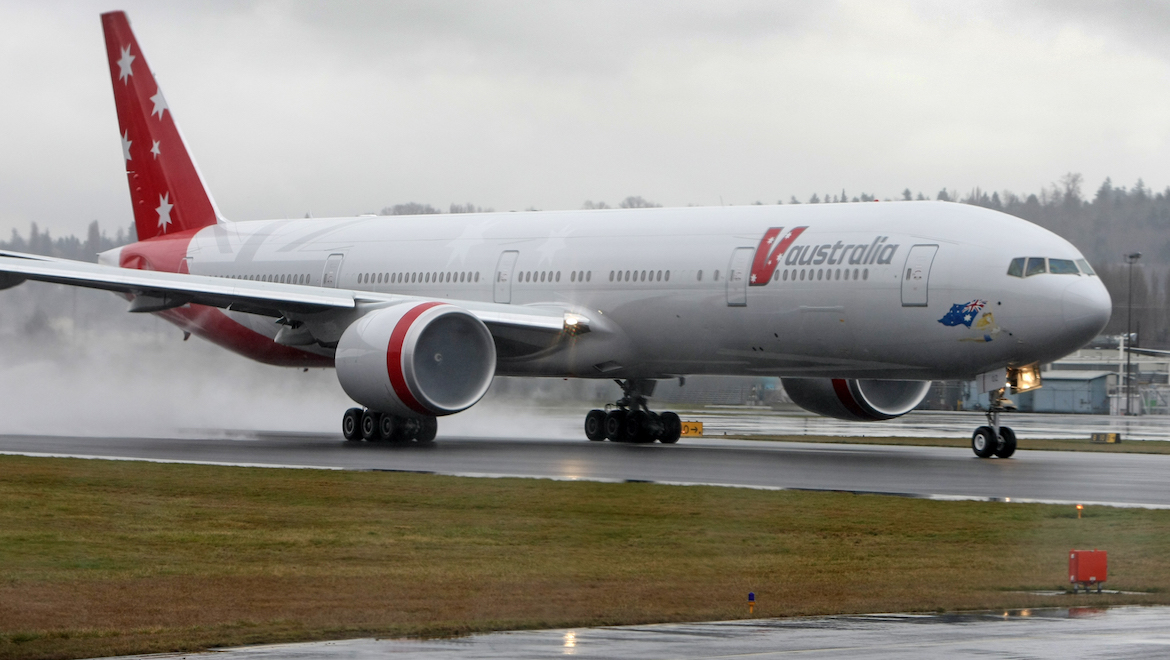
WHAT A TIME TO LAUNCH A NEW AIRLINE
Speaking to a small band of Australian media in Seattle ahead of the delivery ceremony for the first aircraft, Virgin founder and 25 per cent Virgin Blue shareholder Sir Richard Branson and Virgin Blue CEO Brett Godfrey both acknowledged that big challenges lie ahead for V Australia, and that now was probably not the best time to be launching an airline.
“I’ve been in the business for 25 years and I’ve seen four major downturns in that time,” said Branson.
“We had 12 American airlines competing with us out of England when we started and all 12 of those airlines have disappeared or gone bust. The reason that Virgin (Atlantic) has survived is that we created the best quality airline flying in the sky.
“Yes we are launching in one of those cyclical downturns, but we’ll be out there offering consumers the best deals they’ve had in years across the Pacific – they will never have had it so good. Actually, they need it good at the moment because life is tough.”
V Australia was scheduled to have started its trans-Pacific services on December 15, but a crippling prolonged strike by 27,000 members of the International Association of Machinists and Aerospace Workers at Boeing’s Everett, where the 777s are assembled, and Renton plants meant a delay to the delivery of its first three 777s and forced the airline to delay its launch by two months.
That delay meant V Australia had to offer passengers booked on flights it couldn’t operate, many of whom took advantage of the $999 return all inclusive economy launch fares, alternative travel arrangements or complete refunds.
“We were scheduled to have planes delivered in the September, October and November (2008) time and we ended up with two arriving in a month,” said Godfrey.
“We’ve been happy with what Boeing has done as contra compensation. It is no secret that we’ve said we are looking at capacity both domestically and internationally. We are looking at whether or not we do something with these aeroplanes but we’re not saying they have been decided at this stage.”
With the weakening economy, V Australia’s load factor out to July at the time of writing stood at around 45 per cent with most seats heavily discounted as the airline bids to make an impression with the travelling public.
“We heavily discounted because of the Boeing strike and we ended up having to relaunch the airline with two and a half months worth of strong bookings, so we really wanted to get out there with some interest,” said Godfrey.
“The loads are nothing to be disappointed with at all and we’ll work on getting yield over the next 12 months.
“We’ve already lowered the fares on this market by around 30 per cent. That’s a good start I think and there are still some opportunities for us to do more. Like I said, we’d like to see a bit more yield but the loads are quite encouraging.”
“We have been fighting to get permission to fly this route for a long time and having got it we’re going to grab it,” Branson added, “and obviously if you launch when the economy is booming you’re going to get to profit quicker than if you launch when you are in the worst recession since 1929.”
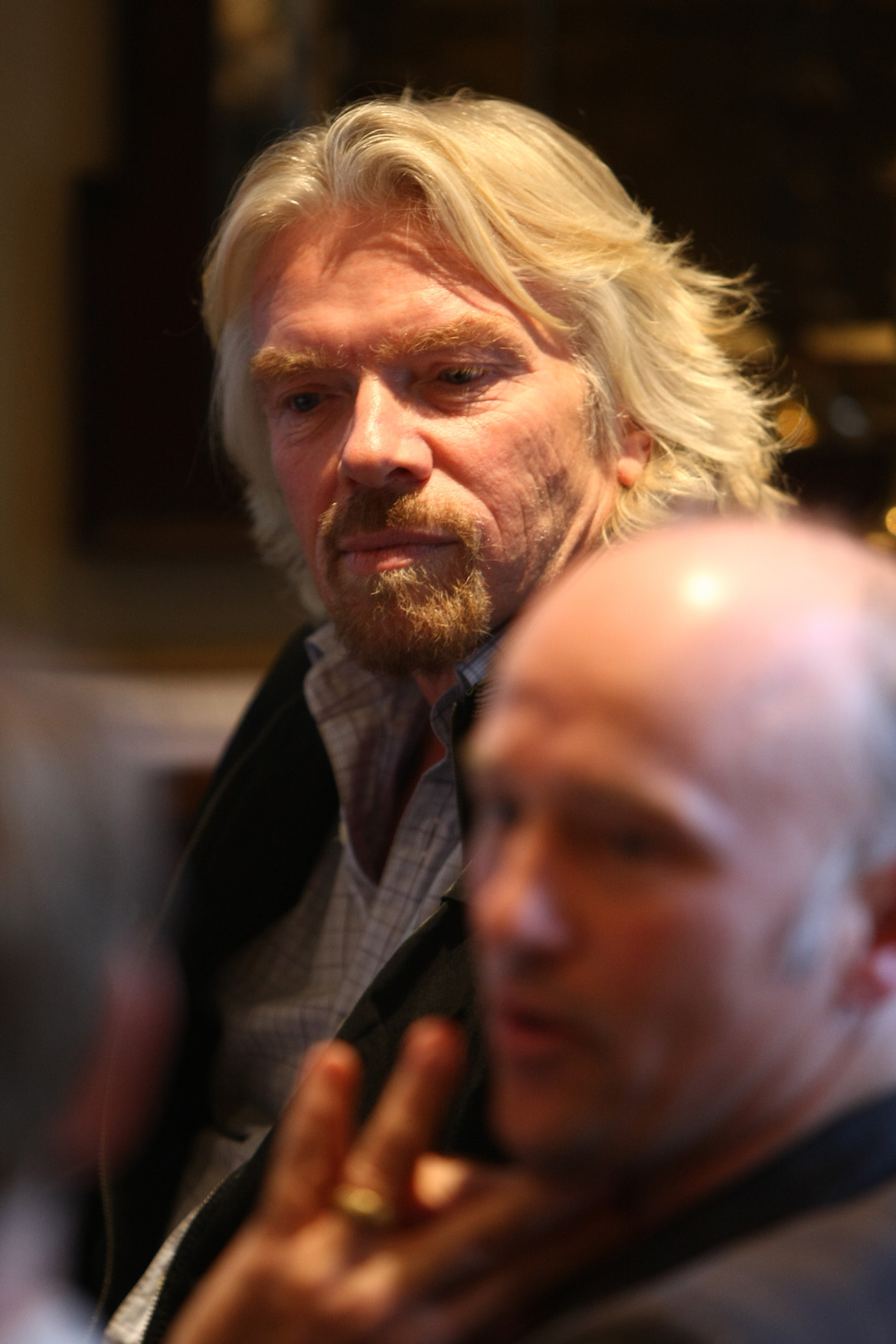
For a long time the Pacific had certainly been a high yielding market, with Qantas and United enjoying an effective duopoly on the Sydney to LA route since Air New Zealand ended its direct Australia-US flights in 2003.
But the fight over the Pacific will become a four-way battle from July when Delta Airlines joins the trans-Pacific market.
“The route has the most expensive business class fares and economy class fares in the world and yet London is 30 per cent further to fly and it’s cheaper,” Godfrey remarked. “There has been a real lack of competition on this route and V Australia is coming in with a great product and great prices. I think it’s going to be a good combination.”
Then from July 1 Delta will begin daily flights between Sydney and LA using new Boeing 777-200LRs.
“We had always envisaged in our business plan for another carrier, be it Singapore (Airlines) or someone else, coming on to this route and we had that happening in 2010 anyway, so Delta coming on sooner rather than later doesn’t change it a heck of a lot,” said Godfrey.
“It’s probably the wrong aeroplane quite frankly to be flying between Sydney and Los Angeles. It’s a long range aeroplane built for 18- to 20-hour missions. From a seat cost perspective talk with the Boeing folks they will tell you there is probably about a 15 per cent differential in terms of seat operating costs between the two (-200LR and -300ER) aeroplanes. So that’s quite a huge advantage for us.”
Equally, Sir Richard was dismissive of V Australia’s other competitors.
“Well, you have United where the quality of service is dire and Qantas which has a mixed bag of (business) seats, some you slide down and I think one plane has flat seats, but overall it’s a mixed bag really.”
Branson also predicts that one of the two US competitors on the Pacific may not survive the current financial turmoil.
“I would put money on either Delta or United not flying across the Pacific within two to three years – one of them will be a casualty,” said Branson. “United would be the likely one to go I would think unless they get their act together.”
Undoubtedly V Australia’s most formidable opponent on the Pacific is parent Virgin Blue’s old foe Qantas, which renewed its defence of the trans-Pacific market in launching Airbus A380 services onto the route late last year.
“They know we’re not going away so there’s no point them attempting to drive us out of business because we don’t get driven out of business,” said Branson.
V Australia’s launch also starts to diminish a key competitive advantage Qantas has held over Virgin Blue in attracting corporate customers – its long-haul network. Consequently, as V Australia builds its long-haul network, Virgin Blue should become more attractive to those lucrative corporate accounts.
“Attracting the business traveller is tough to do without a long haul network. I think we are going to be able to fight on a fairly level playing field,” said Branson.
Virgin Atlantic has also appended V Australia to each of its corporate contracts with Californian companies.
“We’ve spent many years building up a fantastic relationship with the main companies on the west coast of the US and the fact that ‘V’ is going to tag into those deals will help immediately,” Branson said.
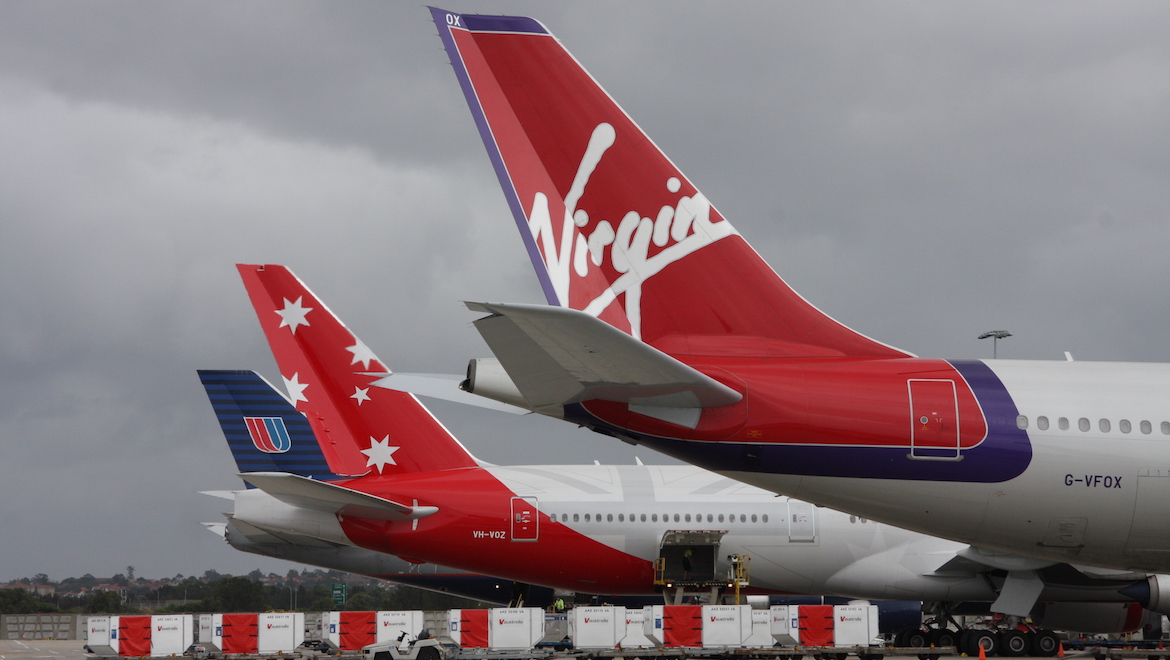
BUILDING A BRAND
Unfortunately Virgin Blue is blocked from using the Virgin brand outside Australia, and so has to build brand awareness of what V Australia stands for and who is behind it.
“It was a left-over from Singapore (Airlines) buying 49 per cent of Virgin Atlantic and I think they had always hoped to be flying on the Sydney-LA route one day and they didn’t want to compete with the Virgin brand,” Branson said in explaining why V Australia could not use the word ‘Virgin’ in its name.
“A challenge for V Australia will be to get awareness into the marketplace, particularly in the US, about the new Virgin Group airline and what it has to offer without using the word Virgin,” said Godfrey.
“In conjunction with Virgin Atlantic and Virgin America we have done a lot of co-branding already. I think a lot of people, particularly Americans, will understand through how we are going to market the airline that there is an association between V Australia and the Virgin Group – it doesn’t have to say ‘Virgin’ on the aeroplane to get that connection – even if the liveries are very similar to each other. I think we will have a better start than if we came in as a non-name.”
The Virgin brand is very well known in the US, initially through the group’s record label, Virgin Atlantic, and now new domestic airline Virgin America.
“If you ask around, the reputation of Virgin America is absolutely tops,” said Branson. “It’s the first time America has had a really good domestic airline and that will help the profile of V Australia enormously there.”
Flying a fleet of Airbus A320s in the US since August 2007, Virgin America was voted the best domestic in Condé Nast Traveler’s 2008 Readers’ Choice Awards – a credible achievement given the airline’s youth.
The strength of the Virgin brand also influences which ports V Australia will serve.
“The cities that we will choose to fly to in the first while will be very select in terms of where the Virgin brand is powerful,” explained Godfrey. “The idea is to tap into that wherever we can and I think we’ll get a free kick from it.”
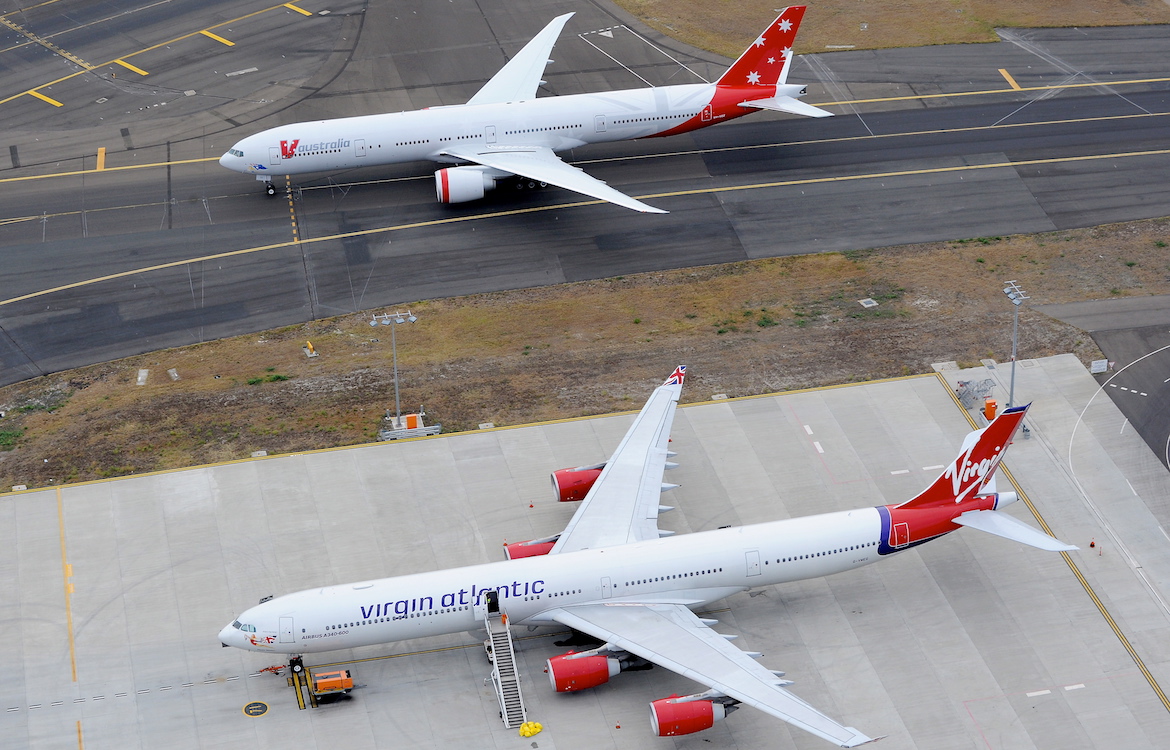
777 WALK AROUND
Building the V Australia brand will certainly be helped by what most observers feel is an attractive aircraft livery, with the 777’s silver mica and red livery emblazoned with elements from the Australian flag. The Southern Cross is draped over the tail with the Union Jack and Southern Cross opaquely visible on the rear fuselage.
“At first, we disappeared under an avalanche of proposals from design companies, artists and brand specialists,” explained Heather Jeffery, Virgin Blue general manager corporate affairs about the origins of the V Australia livery.
“At one stage we had a fleet of large scale aircraft models in the office, with many colours, blues, greens, silvers and always red. In the end, like the original Virgin Blue business plan on the back of a coaster, I’m pretty sure Brett (Godfrey) did some late night thinking and scribbling – there might even be a serviette somewhere!”
“In deciding the final livery of our V Australia aircraft the team considered approximately 30 different options,” wrote Godfrey in VB’s Voyeur inflight magazine.
“The clear favourite – incorporating a silver fuselage with a red tail featuring the stars of the Southern Cross and other abstract elements of the Australian flag.”
Up front the flightdeck is perhaps noticeable for the lack of electronic flightbags (EFBs). V Australia decided not to have the Boeing option of integrated EFBs installed in its 777s and instead is looking at having a laptop driven EFB from a third party supplier.
“The EFBs are really handy but are very expensive to upkeep,” said V Australia line training Captain Kevin Beard. “Third party suppliers have come along and are making them like add-ons to iPods which will be cheaper to buy and offer more functionality.”
Leaving the 777’s flightdeck and passing through the forward galley, there is an access door to the flightcrew rest area that sits above the business class cabin in the aircraft’s crown. It features two business class style seats complete with IFE, plus two bunk beds.
Moving rearwards and the business class cabin is configured in a 2+3+2 seating configuration with each seat offering a 1.95m (77in) pitch. Business class seats convert into 1.88m fully horizontal lie-flat beds that are fitted with a base sheet and duvet by the cabin crew while the passenger changes into special inflight pyjamas in the lavatory.
Business class seats have three axes of adjustment, a lumbar support massager and three pre-set positions for quick adjustments to upright, bed and relax positions.
A test run of features kitted to the business class seat starts with the extension of a 31cm touch-screen display from the centre of the arm rest. Available at every one of the 777’s 361 seats, the V Australia dubbed ‘Red’ IFE (inflight entertainment) is based on Panasonic’s second generation eX2 audio and video on demand (AVOD) touch screen system, which was originally designed for the 787 Dreamliner.
Delays to the 787 sees V Australia become the first airline to introduce the eX2 system, which features inbuilt processors in every screen, resulting in very fast page changes and menu selections.
“These particular screens and the processors were originally destined for the 787,” said Paul Margis, CEO of Panasonic Avionics Corporation. “The screens have a 1Ghz x86 processor and also a digital signal processor built in for handling the video. They are faster than the first generation eX2s screens installed on the Singapore 777s and Emirates and Qantas A380s.”
The eX2 AVOD offers pages and pages of movies and music, games, inflight information and even a chat room. A ‘Qwerty’ keyboard on a retractable hand controller from inside the arm rest allows passengers to type text messages between one another or allows them to join in a whole of aircraft chat session.
Between the seats is a multi type power point for laptops or any device requiring 110 volt AC power.
Underneath the power point is a USB connector for connecting portable music devices, giving passengers the freedom to listen to their own selection of music through the noise cancelling headsets, watch their own videos or even scroll through photo collections. A future expansion of the system will allow for sharing digital images with other passengers.
The screens are also capable of displaying PDF file documents.
A visit to inspect the business class bar passes through the separated row 5. This row of business class can be curtained off into three zones (two left seats, three middle seats and two right seats with two aisles) to give passengers a further level of privacy.
“It could be used by the business class traveller who would like that extra bit of privacy or a VIP or celebrity who doesn’t particularly want to be disturbed,” explained Godfrey.
“We might be able to charge a slightly higher premium for seats in this row but we’re still working that out.”
At the bar four stools face a curved bar top. Passengers are served drinks as they sit under a domed ceiling complete with an LED Southern Cross star constellation.
“It’s fair to say that we wouldn’t have had a bar on board had Richard not spoken to me,” remarked Godfrey. “I wanted an extra three rows of seats so we compromised and found a way to keep the seats we wanted and have the bars, so we have got the best of both worlds.”
Aft of the bar is the premium economy cabin comprising five rows of 2+4+2 all-leather seating featuring 51cm wide seats with a 97cm (38in) pitch and a recline of 23cm. In the seat headrest is a 27cm touch-screen as well as in-seat power and a USB connection.
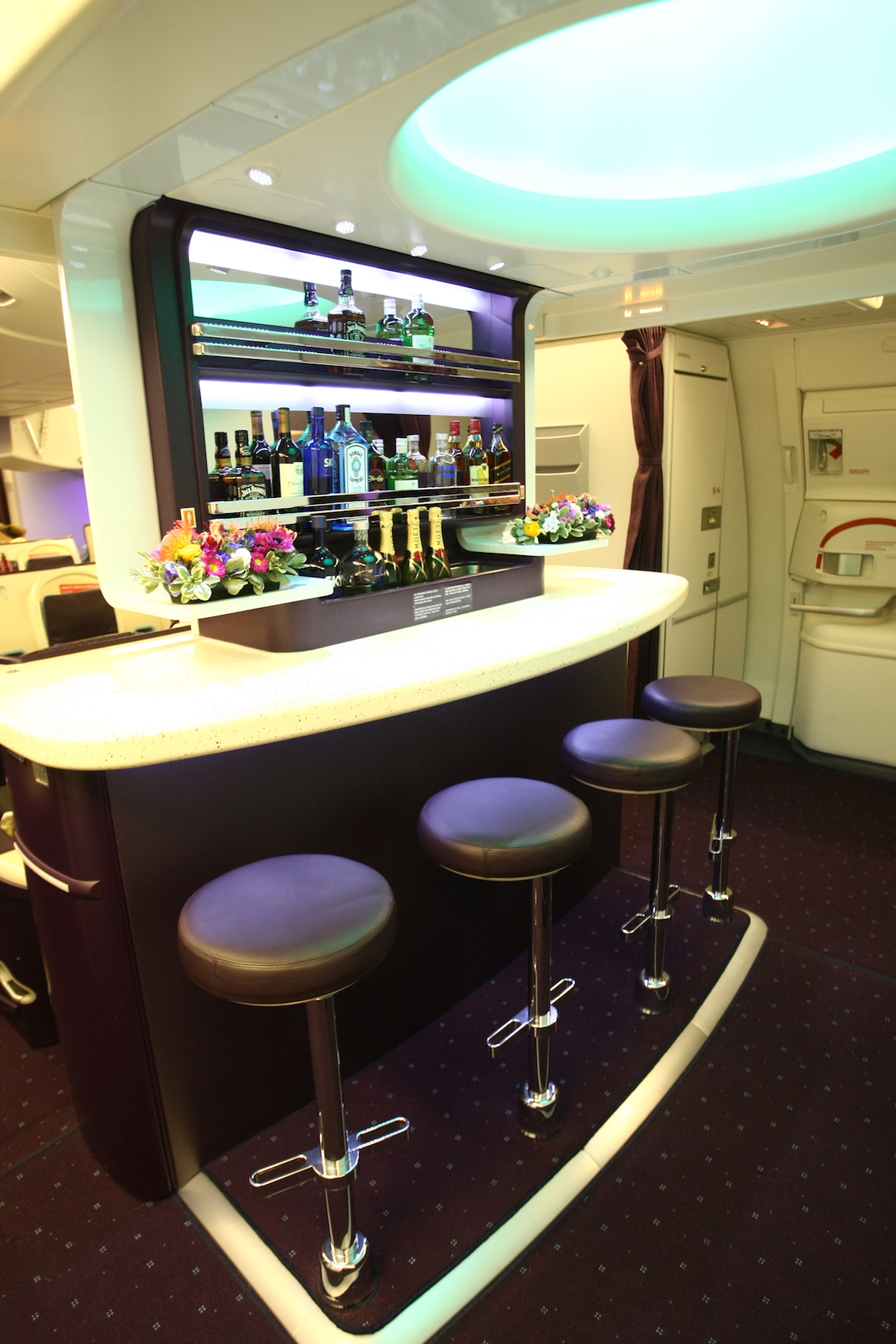
At the rear of the premium economy cabin is the walk-up bar where passengers can self-serve (non-alcoholic) drinks and snacks before returning to their seats. The bar is opened after meals have been served as it is also utilised as a meal preparation area.
Rearward from the middle of the fuselage is economy class, configured in a nine-abreast 3+3+3 arrangement (the 777 can also be configured in a 3+4+3 10-abreast configuration with narrower, 747-style seats). The 288 economy class seats offer a 48cm width, a pitch of 81cm (32in) and a recline of 15cm. The 23cm IFE screens have a USB port, and while there is no in-seat power, there are three charging points available in the rear galley.
“They are the widest economy seats flying across the Pacific,” noted Godfrey.
At the back of the economy cabin is a large galley to cater for the economy cabin. Access to the flight attendant crew rest area above the rear of the economy cabin is by a narrow and steep staircase from the galley. The crew rest area can accommodate up to eight crew at a time in individual bunk beds.
Not long after the airline’s first flight, mobile connectivity will be available throughout the aircraft, using the Aeromobile service. Passengers will then be able to send and receive SMS text messages, as well as send and receive emails using GPRS and mobile data enabled PDAs. Voice calls will be possible in special sections of the aircraft.
So what service can passengers expect when they fly with V Australia? “Lots of smiles and I guarantee you they won’t get bored as they do on a lot of other airlines,” said Branson. “Just as long as they are not served an Indian meal!”
Branson spoke candidly about the infamous letter he received from a disappointed Virgin Atlantic passenger earlier in the year about the meal he was served on a flight from India. “I read it and laughed my head off. I gave him a ring and we had a good laugh together about it. We’d actually won prizes in India for our meals but obviously it wasn’t to an Englishman’s taste at all.”
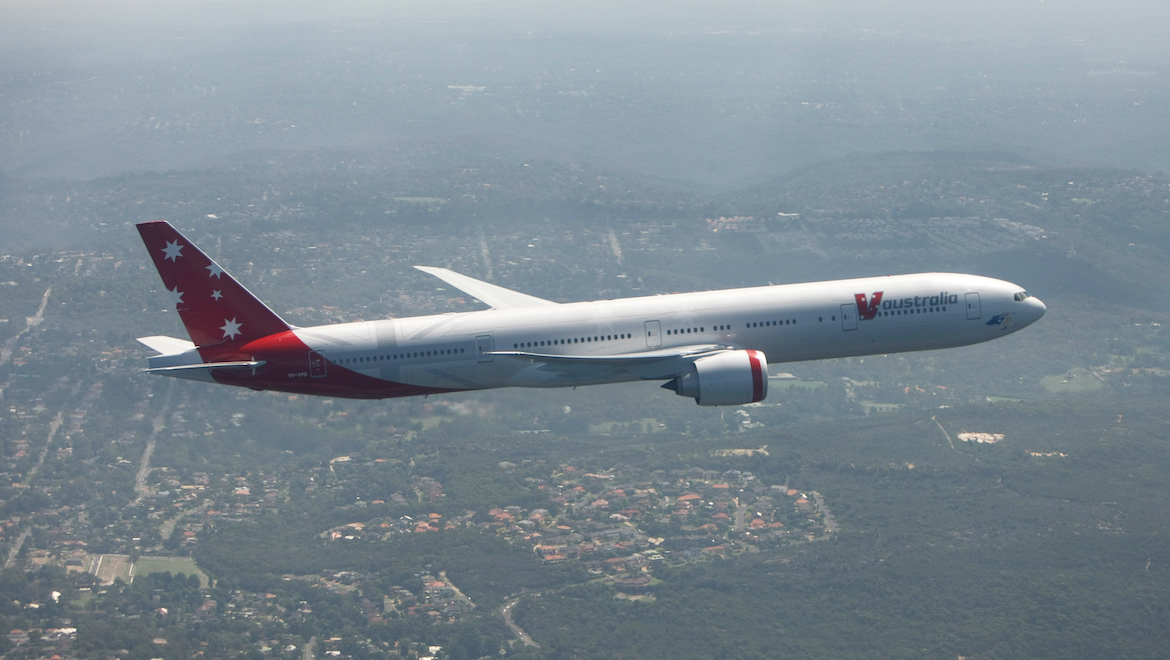
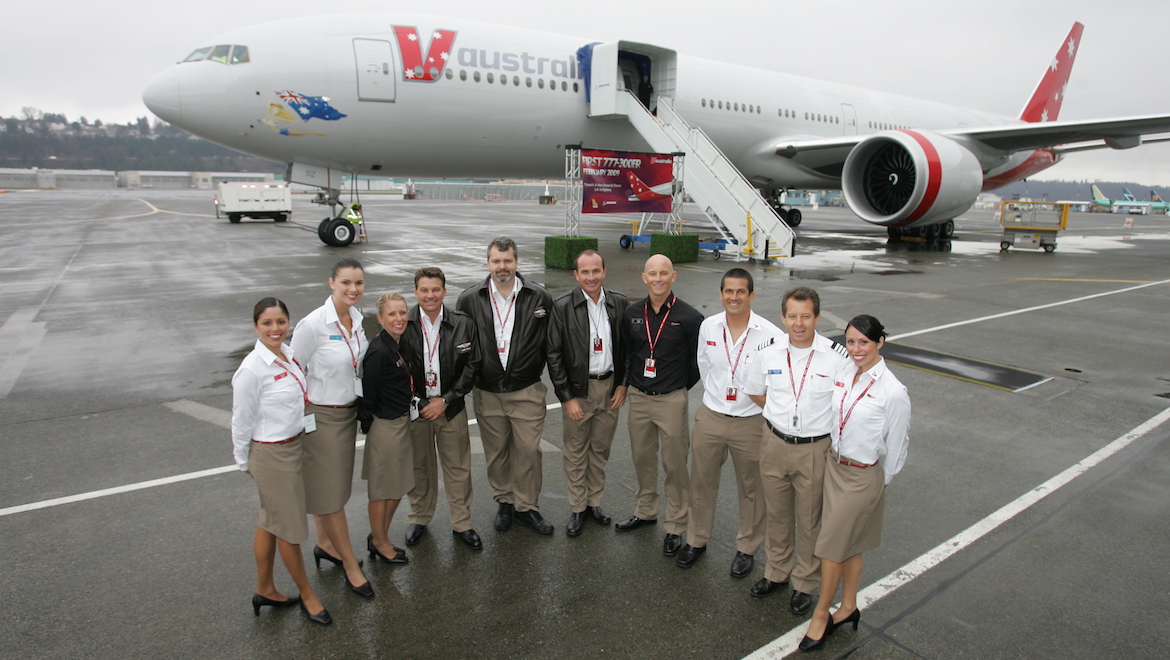
DELIVERING DIDGEREE BLUE
The 78 Virgin Blue and V Australia executives and staff, prize winning Virgin Blue staff, Civil Aviation Safety Authority (CASA) inspectors and Australian media checked in for V Australia’s delivery flight, callsigned ‘VAU 9090’, at Los Angeles International (LAX)’s Terminal 3 on February 7.
As the 777 was due to make a couple of passes over Sydney Harbour before its scheduled 10am touchdown, boarding began half an hour earlier than planned.
Boarding began to applause from the milling passengers at the gate. First in line and presenting their boarding passes at the aerobridge check-in were Brett Godfrey and V Australia executive general manager Scott Swift.
With doors closed, armed and cross-checked, push-back from the gate began at 0033 local time.
From business class seat 4A the LA V Australia ground crew could be seen huddling together in the winter air waving to those on board the 777 as a backup tug was hurried in to replace an uncooperative tug motor for the push-back.
During the engine start and taxi the much talked about safety demonstration video began playing on screens in the cabin and on IFE screens. Influenced by Pixar Animation cartoons (think Buzz Lightyear), a very effective and witty safety demonstration brought giggles from the majority in the cabin. The video was designed to make sure that even a regular ‘I’ve heard it all before’ passenger would sit up and pay attention to all things safety about the flight. It’s a must see!
VIDEO: The V Australia safety video from the newlines YouTube channel.
Thirteen minutes after push-back commenced, Captains Ken Pascoe and Paul Halpin set the 777’s two GE90-115Bs to full takeoff power and VH-VOZ lifted off from runway 24 left and made a shallow left turn for its first waypoint towards Australia.
During the climb a bright flash and simultaneous bang filled the cabin as outside rain slid across the windows.
“Ladies and gentlemen, this is Captain Kenny on the flightdeck. This aircraft is only several hours old and it already has had its first lightning strike.”
A very mild strike hit the aircraft’s left wing with the Captain later revealing that no storms were visible on the weather radar. Ops normal, a return to LAX was not required and the delivery flight continued.
Levelling out initially at 32,000ft and cruising at Mach 0.845 the 777 tracked to the south of Honolulu, gradually reaching its maximum altitude for the flight of 38,000ft somewhere near the equator as it burned through its 120 tonnes of takeoff fuel. From there the route taken to Sydney was north of Fiji and then north of Norfolk Island before tracking directly into Sydney.
During several stages of the flight CASA inspectors put the crew through various drills. “Normally we wouldn’t be involved in delivery flights,” said CASA’s Clive Adams. “Each sector we’ve been checking the guys in an effort to expedite the regulatory approvals before the first flight.”
As the 777 flew above Cairns, the weather forecast for the arrival in Sydney was grim. A low cloud base and reduced visibility saw the Sydney Harbour flyover cancelled and VAU9090 was vectored for an ILS approach into runway 16 right.
At 1010am on February 9 (after crossing the International Date Line) V Australia’s first 777 touched down at Sydney to applause from the passengers and crew on board.
Overhead, Channel 7’s Squirrel helicopter filmed the landing for the evening news and a Bell LongRanger hovered nearby for its photographer to capture the moment for the press.
After taxiing to gate 61 after a flight time of 14 hours and 57 minutes, the chocks were once again set on the aircraft’s landing gear – Didgeree Blue was home.
For the best part of three weeks prior to its first passenger flight V Australia flew its 777s on a rigorous line training program to ports around Australia plus to Auckland.
“We are going to be doing the line training non-revenue in Australia for the best part of three weeks to get enough crews to run the first couple of months’ services,” said Captain Kevin Beard. “Then it will be very intense for us up until July while we complete the rest of the line training.”
V Australia will operate with a flight crew pool of 92. Between 38 to 40 will fly as crew relief first officers who have joined the airline from airlines like Royal Brunei, Cathay Pacific, Emirates and Air New Zealand. Only three Virgin Blue 737 captains have come across to join the V Australia ranks, two becoming captians and the other a first officer. V Australia also sourced six very experienced 777 pilots to become line check and training captains to train up its flight crews.
Having completed ground training, pilots converting on to V Australia’s 777s were doing two sectors in the airline’s 777 simulator at the CAE facility in Silverwater, NSW. Then six sectors were flown in the aircraft comprising four short haul flights in Australia, one return sector to LA under supervision and then a LA return sector as a final check flight.
While training was underway and following CASA’s involvement during the delivery flight, on February 19 CASA issued the airline with its hard earned AOC and 180-minute Extended Diversion Time Operations (EDTO) certificate.
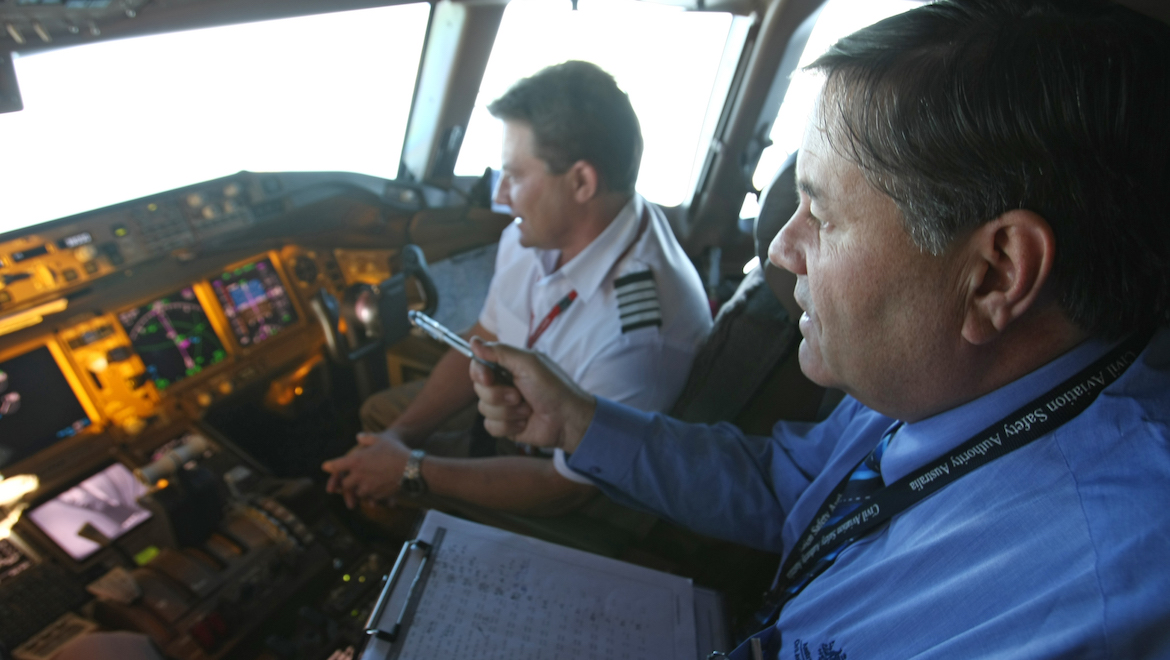
‘V’ictory in the Pacific?
Getting V Australia into the air has cost Virgin Blue an estimated $65 million.
“We said originally it would take about 18 months to break even because of the start-up costs and quite frankly we’re not too far away from that,” said Brett Godfrey.
“We may have to stimulate the market more than we had originally planned (with $1199 return fares), but we didn’t budget on terribly high load factors either so if we have to trade off yield for filling empty seats then the consumer will probably be the big winner this year.
“Airlines make money in some months and lose money in other months so we’re just going to try and fill the planes whenever we can with whatever fare we can get.”
Branson said Virgin Atlantic budgets on five years to break even on a new route, adding, “if V Australia can do it in 18 months then that is fantastic. If we have empty seats I’m sure we’ll get some revenue for those seats and there will be great bargains to be had.”
V Australia is confident it will see a kick in sales now services have begun and the brand is getting established.
“Because of our false start I think a lot of people wondered when we were coming,” said Godfrey. “Once people get on board and see inside the aeroplane for themselves they will make their own mind up.”
V Australia’s objectives are clear. The airline wants to conquer the trans-Pacific route.
“This is a new international long haul airline for Australia. It’s never really had a second international airline, albeit for a brief period, so we see it as a tremendous challenge and responsibility for us as well,” said Godfrey.
“We are confident that we will give anyone who wants to have a go at us a good run for their money.”
The Pacific battlelines are drawn.
Postscript: In 2011, V Australia was renamed Virgin Australia
https://www.facebook.com/virginaustralia/videos/388379901964131/?permPage=1
A video from Virgin Australia’s Facebook page celebrating the airline’s 10 years of operations to the United States.
This story first appeared in the April 2009 edition of Australian Aviation. To read more stories like this, subscribe here.










